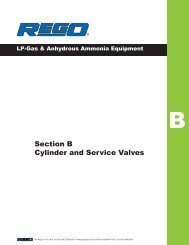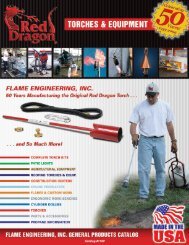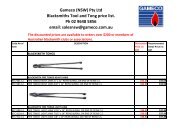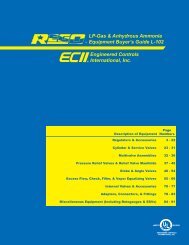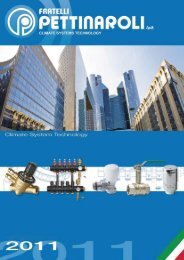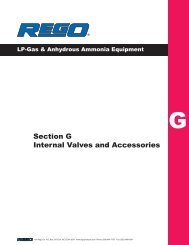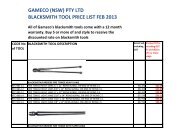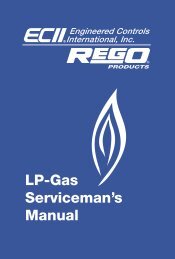Repair Kits Available By Part Number Section 2 Page - GAMECO
Repair Kits Available By Part Number Section 2 Page - GAMECO
Repair Kits Available By Part Number Section 2 Page - GAMECO
Create successful ePaper yourself
Turn your PDF publications into a flip-book with our unique Google optimized e-Paper software.
WARNING: Installation, usage and maintenance of this product<br />
must be in compliance with all Engineered Controls International,<br />
Inc. instructions as well as requirements and provisions of NFPA<br />
#54, NFPA #58, DOT, ANSI, all applicable federal, state, provincial<br />
and local standards, codes, regulations and laws.<br />
This valve must remain in the closed position except during<br />
product transfer. A line break downstream of the pump may fail to<br />
actuate the excess flow valve as the pump may limit flow. If a break<br />
occurs in the system, or the excess flow closes, immediately shut<br />
down the system.<br />
Inspection and maintenance on a periodic basis is essential.<br />
Installation, disassembly, repair and maintenance must be performed<br />
only by qualified personnel.<br />
Be sure all instructions are read and understood before installation,<br />
operation and maintenance. These instructions must be<br />
passed along to the end user of the product.<br />
CAUTION: Contact or inhalation of liquid propane, ammonia and<br />
their vapors can cause serious injury or death! NH3 and LP-Gas<br />
must be released outdoors in air currents that will insure dispersion<br />
to prevent exposure to people and livestock. LP-Gas must be kept<br />
far enough from any open flame or other source of ignition to<br />
prevent fire or explosion! LP-Gas is heavier than air and may not<br />
disperse or evaporate rapidly if released in still air.<br />
Foreword<br />
The A3217F Series 3" Flanged Internal Valves are designed primarily<br />
for use with propane, butane and anhydrous ammonia.<br />
The valve can be used on bobtail delivery trucks, transports and<br />
stationary storage tanks with flanged pumps or piping. It may be<br />
operated manually, by cable or with air.<br />
How The Valve Works<br />
Refer to the drawings in Figure 1. View “A” shows the valve held closed<br />
without leakage by tank pressure and the valve’s closing spring.<br />
Actuation of the operating handle alone does not open the valve, it only<br />
allows pressure to equalize between the inlet and outlet of the valve by<br />
rapid bleeding of the product downstream. This equalized pressure<br />
then allows the valve to open via the internal spring.<br />
The valve opens by moving the handle to mid-point, see view “B”. This<br />
position allows the actuator to put the equalizing portion of the valve<br />
stem in the pilot opening, allowing more product to bleed downstream<br />
than if the handle was fully open.<br />
In a few seconds, the tank and downstream pressure will be nearly<br />
equal. The excess flow spring will push the main poppet to the open<br />
position, see view “C”, the handle should then be moved to the fully<br />
opened position.<br />
If at first, the handle is quickly moved to the fully opened position, the<br />
pilot valve allows a small amount of bleed downstream, but much less<br />
than during rapid bleed ,view “B”. This results in a longer pressure<br />
equalizing time before the main valve can open.<br />
NOTE: The main poppet will not open until outlet pressure<br />
approximates tank pressure!<br />
Once the main poppet is open, flow greater than the excess flow rating,<br />
or a sufficient surge in flow, forces the main poppet closed against the<br />
excess flow spring, as seen in view “D”. The pilot valve in this position<br />
is open and allows a small amount of bleed downstream, but much less<br />
than during rapid bleed ,view “B”.<br />
When the operating handle is moved to the closed position, the valve<br />
closes and a leak-tight seal is re-established as seen in view “A”.<br />
Valve Installation<br />
A 3" 300 lb. ANSI RF flange with a modified bore of 4 5 /8" diameter and<br />
5 3 /4" RF must be installed in the tank. New studs and nuts are also<br />
recommended. Be sure flange is clean, smooth and free of imperfections<br />
before valve installation. Coat the full length of the studs with an<br />
anti-seize compound to prevent rusting and provide for easy removal<br />
of the valve for maintenance.<br />
Place gasket with larger Interior Diameter on top flange of valve body<br />
to seal against tank opening.<br />
NOTE: The screen should be removed if the valve is to be used<br />
for both filling and withdrawal service or for filling alone.<br />
Support and position valve under flange opening of tank in its installation<br />
position. Be sure that:<br />
a) the handle is in a fully operable, convenient position and free of all<br />
obstacles, and that<br />
b) the handle is oriented in the proper direction to accommodate<br />
controls.<br />
Carefully insert valve into flange opening and onto the studs. Tighten<br />
two opposite nuts and bring valve flush to flange with gasket in place<br />
in groove – see Figure 2. In sequence, start six remaining nuts and<br />
tighten all nuts securely, side-to-side and alternately.<br />
Place gasket with smaller Interior Diameter on bottom of lower flange<br />
before connecting pump or mating flange.<br />
A hydrostatic relief valve need not be installed between the A3217F<br />
and next adjacent shut-off valve as excessive line pressure is automatically<br />
relieved by the internal valve into the tank.<br />
After valve, pump and system piping are fully installed, run a thorough<br />
leak test using a high quality leak detection solution. Unit must be leakfree<br />
before being placed in service. In addition, the system must be<br />
tested for excess flow valve operation by simulating a break downstream<br />
at the furthest point being protected.<br />
WARNING: This test must be performed in a safe location, as<br />
testing with flammable gas is extremely hazardous. Only authorized<br />
trained personnel should perform this test.<br />
NOTE: To provide excess flow protection, the flow rating of the<br />
pump, piping, valves, fittings and hose on the inlet and outlet<br />
sides of the valve must be greater than the flow rating of the valve.<br />
Keep piping from the valve outlet to the pump full-size and as<br />
short as possible with a minimum number of bends. Any restrictions<br />
that reduce the flow to less than the excess flow valve rating<br />
will result in the excess flow valve not operating when required.<br />
Cable Control System<br />
The cable control system employed must meet the requirements and<br />
be in accordance with the provisions of NFPA #58, DOT, ANSI, and all<br />
applicable federal, state, provincial and local codes.<br />
Valve Operation and Precautions<br />
1. Valve must be opened before starting pump, and before opening<br />
valve on pump outlet.<br />
2. Leave pumping system “wet” to avoid drying of seals and to reduce<br />
time involved in opening valve. Drain piping only when required by<br />
codes or safe operating practices.<br />
3. When piping is dry or at a lower pressure than the tank, open valve<br />
half-way for a few seconds to allow line pressure to equalize before<br />
fully opening the valve handle. The main poppet may not open<br />
immediately if the handle is placed in the open position too quickly.<br />
4. Flow surges may close the built-in excess flow valve and should be<br />
avoided. If the valve slams shut, immediately stop the pump, close<br />
the nearest downstream valve, and move handle to midpoint<br />
position to equalize pressure until valve reopens with a click, then<br />
restart pump and open downstream valve slowly.<br />
5. Always keep valve closed except during product transfer.<br />
6. Avoid partially opening valves during pumping. The resulting restriction<br />
may prevent excess flow valve from closing when required.<br />
7. All personnel must be aware of remote closure locations and their<br />
operation in case of an emergency.<br />
8. Never, under any circumstances, permanently wire open the operating<br />
handle of the internal valve.<br />
Troubleshooting<br />
1. Internal Valve Will Not Open<br />
Causes may be excess leakage downstream as pressure cannot<br />
equalize, pump engaged too quickly, excessive wear of valve, or ice<br />
freezing of poppet.



